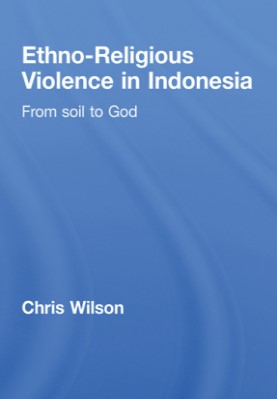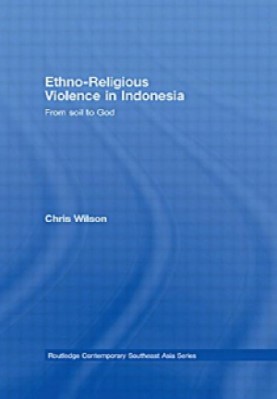Ethno-Religious Violence in Indonesia: From Soil to God

| Ethno Religious Violence In Indonesia |
| Chris Wilson |
| 257 |
| |
| PDF Direct Download Link |
| Click for Hard Copy from Amazon |
ETHNO-RELIGIOUS VIOLENCE IN INDONESIA – Book Sample
Introduction – ETHNO-RELIGIOUS VIOLENCE IN INDONESIA
Behind a mosque in the remote coastal village of Kao in North Maluku, eastern Indonesia, there lies a large stone grave. The remains of seven warriors rest inside the tomb, all members of the Kao ethnic group who died in a clash with Dutch soldiers in the first decade of the twentieth century. The gravesite holds special significance for Kaos.
It is the resting place for both Christians and Muslims, a symbol for the Kaos over the past century of their strong ethnic solidarity, regardless of religious differences. For most of the twentieth century this concord was also representative of the North Maluku community as a whole. In 1999, however, this society, which had long prided itself on inter-religious harmony, descended into bloody religious war.
Devastating communal violence often begins with a series of events that in hind- sight could easily have been contained. In August 1999 a small ethnic dispute erupted in a village on the large island of Halmahera, to the east of Sulawesi, marking the beginning of a series of clashes that brought horrific consequences to the entire region.
Throughout North Maluku, over 3,500 men, women and children were killed by opposing mobs armed with machetes, spears and bows and arrows. Several hundred thousand people were displaced from their homes, and the fighting destroyed much of the region’s housing and infrastructure.
This book attempts to account for this violence. In particular it seeks to explain five aspects of the conflict: why violence began; how it evolved from a small dispute into a religious war; why it reached such a frightening level of intensity; why it spread across the entire province; and why it ceased.
This introductory chapter begins with an overview of the violence and its consequences. The second section gives an overview of the existing literature on the conflict.
The conflict: August 1999 to June 2000
Before August 1999, North Maluku had seen half a century of peace and stability. The region, which until September 1999 comprised two relatively remote districts in the north of Maluku Province, was far removed from national politics.
While it did not benefit significantly from Indonesia’s economic boom, North Maluku enjoyed relative self sufficiency and good relations between ethnic and religious groups. Even the onset of terrible religious violence in Ambon in the southern part of the province in January 1999 (discussed in Chapter 2) caused little damage to inter-religious relations in the region.
Yet, in August of that year, just as North Maluku prepared to become an independent province and reap the benefits of Indonesia’s new era of political liberalization and regional autonomy, this harmony was shattered.
On the night of 18 August 1999 two ethnic communities – the Makians, long-term migrants to the area, and the indigenous Kaos – clashed in a village in remote Malifut on Halmahera Island (see Map 3.1).1 As dawn broke and the Kao village of Sosol lay in ruins, thousands of Makians moved on to and quickly overran neighbouring Wangeotak village. Three Kao men perished in the fighting.
Two months later, just after the inauguration of North Maluku Province, the Kaos retaliated, driving all Makians from Malifut and destroying their villages. Because the Kaos were predominantly Christian and the Makians Muslim, the stage was set for the large-scale religious conflict that was to sweep through North Maluku, despite the fact religion had been inconsequential to their initial dispute.
Thousands of Makians fled to the provincial capital, Ternate, where retaliatory violence erupted, as well as on the neighbouring island of Tidore and some areas of Halmahera. Mobs targeted not just Kaos, but any member of the Christian minority.
Rioters destroyed Christian houses and churches, while Christians fled to local police and military compounds. Dozens of people were killed, including a Protestant pastor on the island of Tidore (his body dismembered and burned). These riots had a far greater impact than the Malifut incident, sending shockwaves across the province.
From this moment, almost the entire North Maluku commu- nity divided along religious lines. In a classic ‘security dilemma’, communities began preparations either to defend themselves or, in some cases, to launch pre-emptive attacks against their neighbours. Over the following months, violence spread out across the region, affecting Halmahera, Bacan, Morotai and all the islands in the archipelago.
The violence reached its brutal peak in December 1999 in Tobelo and Galela Sub-Districts in north Halmahera, which had almost equal populations of Muslims and Christians. After fighting began in Tobelo City, Muslims took control of the town for just one night before thousands of Christians, armed with homemade weapons and bombs, flooded in from rural areas.
Over the next two days, these Christians expelled the entire Muslim community from the town and surrounding villages. Perhaps a thousand people died in the carnage, including women and children.
This violence immediately flowed into the sub-district of Galela, where militia attacks quickly divided the area into exclusively Muslim and Christian enclaves. During this inter-religious violence in north Halmahera, Ternate also descended again into fighting, this time between Muslims.
After these intra-Muslim clashes ended, the opposing Muslim factions set aside their differences in order to retaliate against Christian militias on Halmahera. They sought to legitimize these assaults by reference to the principles of jihad.
The violence finally ended in July 2000 after the fall of the Christian village of Duma in Galela, which had resisted attacks for six months. Shortly afterwards, in response to continuing violence in Maluku and North Maluku, President Abdurrahman Wahid declared a Civil Emergency in the two provinces. Combat- ants in North Maluku thereafter faced a more effective response from the security forces.
Perhaps more importantly, the violence had segregated Christians and Muslims into separate areas of the province, divided by sizeable military contin- gents, and continued attacks were untenable for the exhausted militia members.
After almost one year of violence, over 3,000 people lay dead. The populations of many villages had been decimated, and Halmahera was littered with mass graves. Innumerable people from both communities remained in hiding in the dense and vast forests of the island. Statistics distributed in March 2000 by the North Maluku Governor’s Office stated that 2,083 people had by that date died during the conflict.
Although the local government restated this figure in 2003 as a final estimate, the actual number of deaths was almost certainly higher. Further incidents between March and June saw large loss of life, most notably attacks on the villages of Duma, Makete, Dokulamo and Mamuya in Galela, and the tragic sinking of the Cahaya Bahari passenger ship, in which approximately 500 people drowned.
The official statistics do not include an estimated 250 casualties from violence in the sub-district of Payahe in November 1999, nor do they include casualties among the local Islamic militia, the Pasukan Jihad (Jihad Force), who were killed outside their home sub-districts.2 According to one leader of this militia, approxi- mately 200 mujaihid died in North Maluku.3 By July 2000 between 3,000 and 3,500 had died. The large number of missing persons cited in March 2000 (2,315) suggests an even greater death toll.
The Governor’s Office reported that the violence displaced approximately 250,000 people.4 Of these, 199,605 were displaced within North Maluku Province and 48,015 were forced to flee to elsewhere in Indonesia. Given that this figure was compiled several months before the end of hostilities, the final figure was probably higher, although most people had already fled their homes by the time these figures were collated. Most Muslim Internally Displaced Persons (IDPs)5 were evacuated to Ternate, almost doubling that city’s population to approxi- mately 180,000.
Some also sought refuge outside North Maluku in South Sulawesi. Perhaps 15,000 Christian IDPs fled to the Christian-dominated city of Tobelo in north Halmahera. The majority of Christians, however, went to the prov- ince of North Sulawesi (see Map 0.1) and were settled by the local government in camps in the cities of Manado and Bitung. In 2005, many IDPs remained in North Maluku and North Sulawesi.
Many have settled around their displacement camps in areas such as Tobelo, rather than returning home. Others feel unable to return home because of a lack of government assistance, or because they fear reprisals or new outbreaks of violence.
North Maluku’s infrastructure, particularly on Halmahera, was devastated. According to the March Governor’s Office report, 18,022 houses, 97 mosques, 106 churches and 110 schools were destroyed. The final number of buildings destroyed was undoubtedly much higher. Most villages located in a sub-district dominated by the opposing group were destroyed entirely. Combatants destroyed bridges, telephone poles, fishing boats, warehouses, gardens and other infrastructure crucial to North Maluku’s economic and social life.
To some extent, the conflict in North Maluku also affected national politics and society. The intense violence in Tobelo in late December 1999, which involved the deaths of almost a thousand Muslims and was described in often inflammatory terms in the national media, stimulated the formation in Java of a large Muslim militia, the Laskar Jihad.
This organization, which gained national and interna- tional notoriety, became involved in communal violence in Maluku Province, although not, as this study will show, in North Maluku.
Studies of the conflict and remaining questions
This book seeks to account for this tragedy. What caused violence to start and to escalate is a question not just for Indonesia, although the social, economic and political costs of the conflict were severe for the immediate region and archipelagic nation, as discussed above.
The causes of a violent communal conflict of this magni- tude are of relevance to the global community. In addition, the fact that the violence occurred during Indonesia’s transition from an authoritarian political system is a reminder of the pitfalls of rapid democratization and decentralization.
Similarly, the fact that most of the violence occurred between Muslims and Christians presents lessons for the relationship between these two communities.
In order to capture the complexity, temporal dynamism and geographical variation within the North Maluku conflict this study is divided into five chronological phases. The phases are essentially new outbreaks of violence, each involving several unique political, economic and social variables. In some cases, these events involved riots by a majority group against local minorities.
In others, clashes took place between relatively evenly balanced forces. While each new outbreak was influenced by those preceding it, each also had its own specific dynamics and causes. The events in these five phases defined the trajectory of the conflict as a whole, determining how it began, escalated, spread, was exploited by political actors and ended in religious war. The phases are listed in Table 1.
The following section discusses each phase in turn, beginning with a summary of the existing literature on the events in question. Commentators, the majority of whom are from North Maluku, have compiled a substantial body of literature on
To read more about the Ethno Religious Violence In Indonesia book Click the download button below to get it for free
Report broken link
Support this Website
for websites
